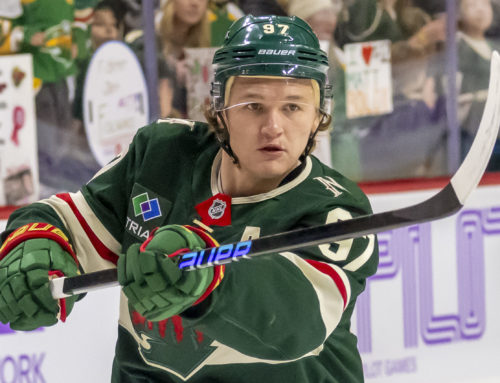With the 2024–25 regular season in the books, I wanted to mess around with a few datasets that haven't been front and center all year. I grabbed time on ice and advanced possession stats for every NHL skater this season and started slicing things up, not with the goal of proving any grand theory, but just to see what kinds of patterns pop out when you stack players side by side. All data was taken from Hockey Reference.
This isn't a fantasy piece or a deep tactical breakdown. It's more of a zoomed-out look at roles, performance indicators, and weird little outliers. The charts below explore ice time deployment, Corsi-relative values, expected goals impact, and how often players get their shots through traffic with a few key names highlighted when the data demands it.
Everything's filterable by team, position, or minimum games played if you want to poke around further.
Let's get into it.
Power Play TOI vs. Shorthanded TOI
This chart compares how much time players logged on the power play (x-axis) versus the penalty kill (y-axis). The top-right is where you'll find the true dual-responsibility guys; players who get consistent minutes on both special teams units. That's typically a defenseman-heavy crowd, but there are a few high-trust forwards mixed in too.
Bottom-right is stacked with players who are PP specialists, the guys leaned on for offensive zone pressure but rarely sent over the boards when shorthanded. On the flip side, the upper-left is home to penalty kill regulars who don't touch the power play. These are often depth guys or defensive-minded forwards.
Then there's the bottom-left: players who aren't staples on either unit. That's not a knock, it's just some of these guys just don't have locked-in roles yet, or they contribute in other ways at 5-on-5.
Even Strength Corsi Rel vs. PDO
This chart maps out Corsi For Relative (CorsiRel) at even strength on the x-axis and PDO on the y-axis. In plain terms, CorsiRel tells us how effective a player is at driving shot attempts compared to their teammates when they're on the ice. PDO, meanwhile, blends on-ice shooting and save percentage, it’s often used as a luck barometer.
Top-right? That's the sweet spot: players who are both tilting the ice and seeing results. Bottom-right shows drivers who haven't had the puck luck. Top-left is the opposite, or guys riding some favorable percentages without the underlying support. And the bottom-left is… well, no one wants to be in that quadrant.
It's a dense chart of nearly a thousand skaters, so zoom in, use the filters, and poke around. You might find a breakout line, a struggling star, or a role player quietly winning their minutes.
Power Play Corsi Rel vs. PDO
Same idea as the last chart, this one plots Power Play Corsi For Relative on the x-axis and PDO on the y-axis, but now we're isolating special teams. As expected, the top-right is where the real PP weapons live: high shot volume and good results. Alex Ovechkin's parked up there, no surprise.
There's a massive cluster in the middle, though. That's the soup of secondary options, fourth forwards, and role guys who log a bit of power play time but don't always tilt the needle. Filtering by games played or team can help cut through that clutter.
This view helps you figure out who's actually making an impact when their team's up a man, and who's just out there.
Shorthanded Corsi Rel vs. PDO
This one flips the script, we're now looking at short-handed Corsi For Relative vs. PDO. It's a bit niche, but it reveals some interesting surprises.
That right side? It's not just defensive grinders. You'll spot some skilled forwards who are genuinely driving play while killing penalties, guys who don't just survive the PK, but generate pressure the other way. Unexpected names show up here, which makes this quadrant worth exploring.
On the flip side, the left side shows players who are struggling to get results while shorthanded. Not necessarily a red flag, but definitely a development area for certain roles.
Give it a look, there are some eye-openers in here.
Expected Plus Minus vs. Even Strength Corsi Rel
This one's a bit more nuanced. We've got expected plus-minus on the Y-axis and even-strength Corsi Rel on the X.
Expected ± isn't your regular plus-minus because it's built off shot quality and location. It looks at the shots for and against while a player is on the ice, then scores them based on league-average shooting percentages from those spots. It's not perfect, but it does a decent job of blending on-ice results with process.
Here's where it gets fun: the top-right. That's where you find the best of the best, guys tilting the ice and keeping quality chances going their way. The Oilers top unit lights this up like a Christmas tree; Connor McDavid, Zach Hyman, Evan Bouchard, Mattias Ekholm, Leon Draisaitl are all clumped up, and it's terrifying. Just a heads-up: if you're playing Edmonton, pray that the group isn't rolling.
You can do the same exercise for other teams too. Carolina has some spicy names in their quadrant. Florida looks sharp across the board. And some teams, well, they've got passengers. Zoom in, poke around, find the drivers. This chart rewards a second look.
Shot Attempts vs. Through Percentage
We're wrapping things up with a simple but revealing one, Shot Attempts on the X-axis and Through Percentage on the Y.
Shot Attempts covers every puck a player tries to fling toward the net, whether it actually makes it there or not. Through Percentage tells us how often those attempts make it past defenders and actually get to the goalie. So naturally, this chart shows us who's just blasting pucks into shin pads, and who's threading the needle.
Bottom-left? That's where you'll find your volume chuckers with zero finesse, like defensemen who throw muffins from the blue line but hit legs more than twine. The top-right is where it gets fun – careful, calculated shooters who pick their moments and get rewarded. Most of them are high-end scorers, and they live up there for a reason.
There's also a curious cluster in the top-left, players who don't shoot much, but when they do, they're efficient. Could be a small sample, could be smart shooting. Either way, it's worth hovering over a few names. You might find some sneaky value picks.
That's the rundown. No sweeping conclusions here, just a bunch of ways to look at the same season through different lenses. Whether you're scouting trends, highlighting your favorite player, or just curious which defensemen are allergic to getting pucks through, there's something to chew on in each chart. As always, the data only gets more interesting the deeper you dig, so feel free to run with it. We'll be back soon with another angle to explore.





 FLA
FLA CHI
CHI NYR
NYR PIT
PIT L.A
L.A COL
COL CAR
CAR UTA
UTA SEA
SEA
 NYI
NYI TOR
TOR VAN
VAN
